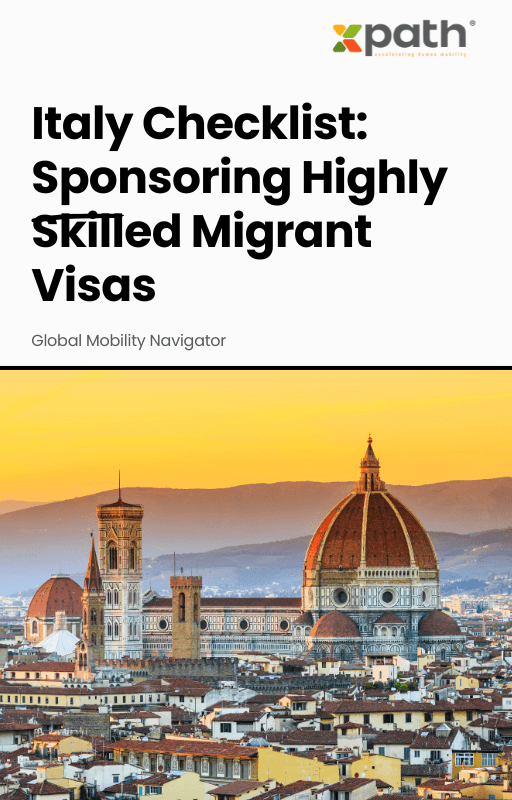Italy Checklist: Sponsoring Highly Skilled Migrant Visas
Grab a copy of a guide to international employee relocation
View E-bookPicture this: your company is expanding into new markets, and you’re tasked with relocating top talent across continents. The pressure is on to ensure every employee transition feels effortless—no missteps, no missed deadlines, no surging costs. In today’s connected world, global mobility technology is the engine that powers these seamless transitions. But, like tuning a high-performance vehicle, implementation can get complicated. So, how do you get it right the first time? This article dives deep into best practices for a flawless global mobility technology rollout, complete with insider trends, common roadblocks, and a peek at cutting-edge platforms like xpath.global.
First, let’s break it down—what exactly is global mobility technology? At its core, it’s the suite of digital tools designed to manage international assignments, employee relocation, immigration, tax compliance, and more. This tech automates the nuts and bolts of moving talent around the globe while offering strategic insights through data analytics. In a 2023 report by KPMG, over 60% of multinationals said they rely on dedicated global mobility platforms to boost program efficiency and compliance.
Digital transformation isn’t just a buzzword—it’s reshaping how companies approach workforce mobility. According to the 2023 Deloitte Global Mobility Trends report, 70% of companies accelerated tech investments for mobility management post-pandemic. The rise of hybrid work models and an increasingly mobile workforce pushed organizations to seek smarter solutions. For instance, cloud-based platforms like xpath.global centralize data, automate tedious processes, and support real-time collaboration between HR, assignees, and vendors worldwide. The result? Faster relocations, happier employees, and real cost savings.
Let’s be honest: implementing new technology can feel like trying to change the tires on a moving car. Resistance to change, integration headaches with legacy HR systems, and unclear goals can slow you down. A 2022 EY survey found that 43% of mobility teams identified data integration and change management as the top implementation snags. So, what’s the secret sauce?
The answer lies in early stakeholder engagement. Bring IT, HR, finance, and even relocating employees into the conversation from day one. Next, prioritize interoperability; custom APIs, like those offered by xpath.global, enable smooth syncing with existing payroll, immigration, and travel systems so nothing gets lost in translation. And don’t underestimate the power of good training—a well-prepped team can unlock the full power of your new system from the get-go.
Take the example of a global consulting firm that moved more than 200 employees annually across Europe, Asia, and the Americas. Previously, they juggled a patchwork of spreadsheets and manual emails—a recipe for errors and burnout. They turned to a comprehensive platform (powered by xpath.global) that unified case management, automated immigration status updates, and provided real-time spend analytics. Within six months, delayed filings dropped by 80%, administrative workload fell by half, and employee satisfaction scores soared. The firm’s HR director summed it up: “With xpath.global, our program runs like clockwork. Our people feel supported no matter where they land in the world.”
Dreaming of similar results? Here’s a proven path to follow:
Start with clear objectives. What problems do you want to solve—faster onboarding, cost control, compliance risks, or employee experience? Map your mobility processes, then audit existing technology to pinpoint gaps. Vet platforms for user-friendliness, scalability, and global support. Look for flexible integration capabilities like those in xpath.global for compatibility with your HR and finance tech stack. Pilot with a small user group, gather feedback, and iterate before a broad rollout. Build a robust communication and training plan. Anticipate hiccups, celebrate quick wins, and keep refining as you go. Remember, the journey is just as crucial as the destination.
The landscape of global mobility is rapidly evolving. AI-powered analytics, automated compliance alerts, and personalized employee portals are quickly becoming standard features. Organizations that modernize early won’t just avoid pitfalls; they’ll gain a competitive edge by attracting and retaining global talent with frictionless relocations. Platforms like xpath.global are constantly innovating, keeping clients ahead of regulatory shifts and rising employee expectations.
It means minimal disruption to business, quick user adoption, and measurable improvements in relocation speed, compliance, and satisfaction.
It varies by company size and complexity, but a phased approach with platforms like xpath.global can see core modules live in 2–3 months.
Absolutely. Look for platforms with robust security certifications, data encryption, and compliance with data privacy laws like GDPR.
Involve key teams early, highlight value (like cost savings or better employee experience), and leverage pilot successes as proof points.
Yes. Best-in-class systems (like xpath.global) are designed to flex as your program or global footprint expands.
Ready to transform your mobility program? Explore xpath.global’s solutions.

Italy Checklist: Sponsoring Highly Skilled Migrant Visas
Grab a copy of a guide to international employee relocation
View E-book